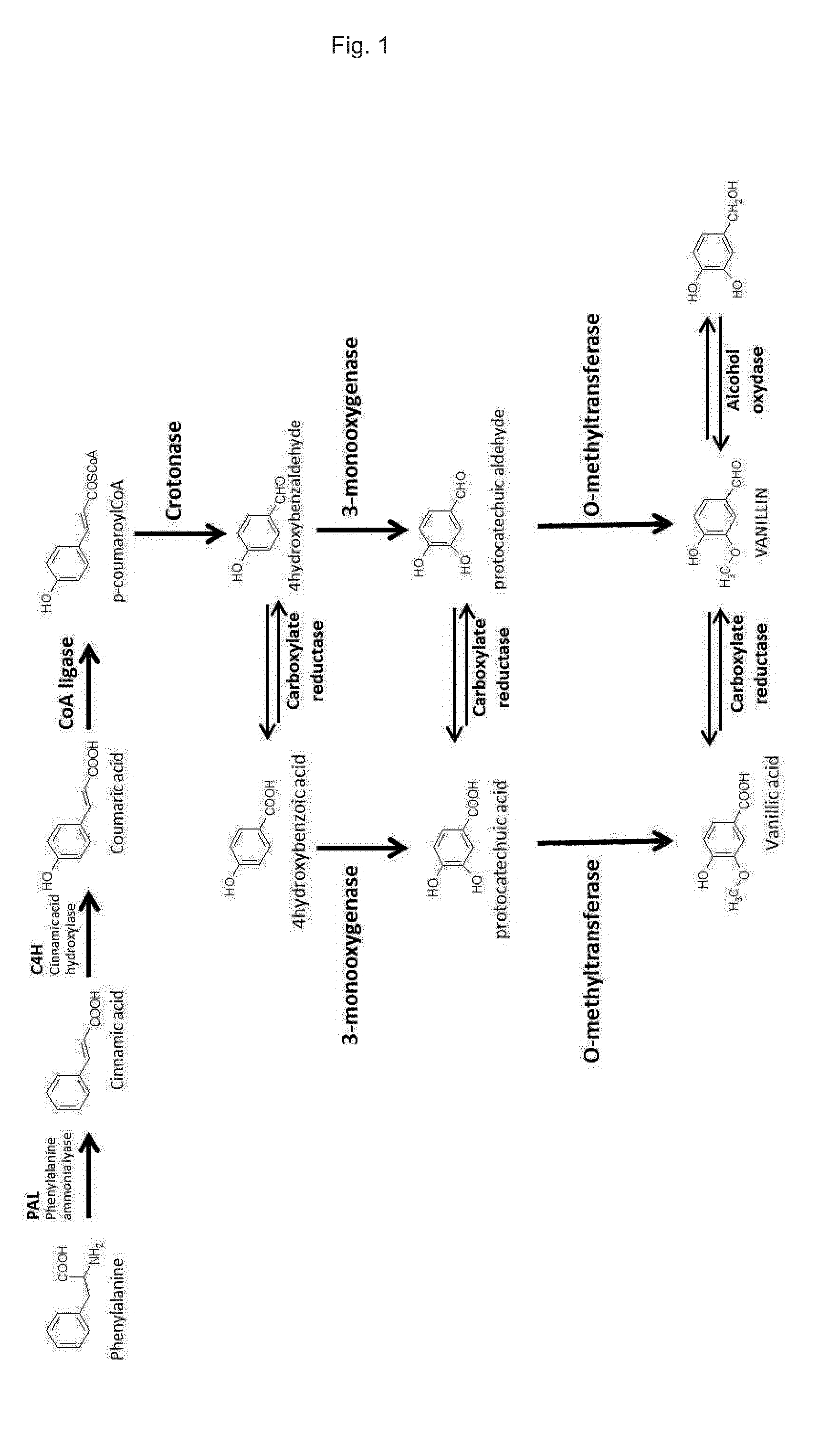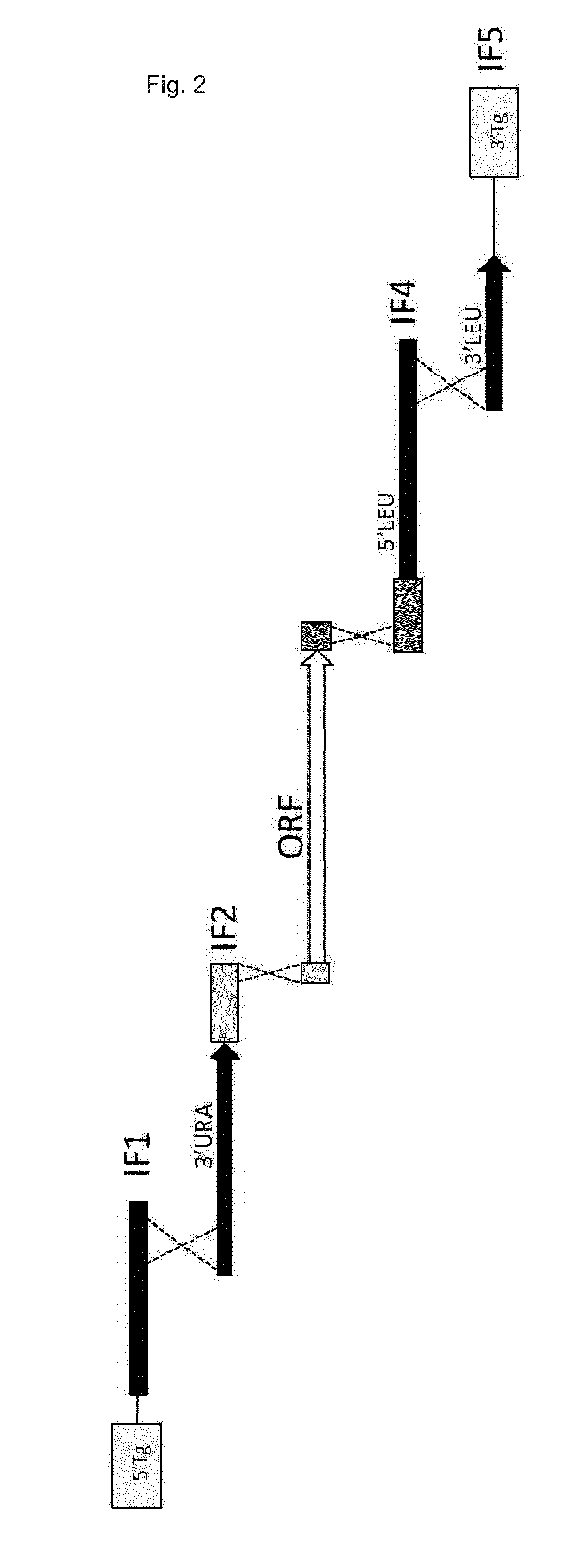Recombinant host cell for biosynthetic production
a biosynthetic and host cell technology, applied in the direction of transferases, lyases, applications, etc., can solve the problem of relatively high cost of natural vanillin extracted from orchid i>vanilla planifolia /i>beans, and achieve the effect of enhancing or enhancing the capacity for vanillin formation
- Summary
- Abstract
- Description
- Claims
- Application Information
AI Technical Summary
Benefits of technology
Problems solved by technology
Method used
Image
Examples
example 1
Artificial Vanillin Pathway: Metabolic Pathway to Produce Vanillin Using Phenylalanine as Precursor Compound
[0275]Since vanillin is not an endogenous metabolite, it is necessary to recreate a synthetic production pathway in yeast. The vanillin synthesis starts as all phenylpropanoids with phenylalanine which is produced endogenously by the cell. Six enzymes are required for the conversion of L-phenylalanine to vanillin (FIG. 1). Phenylalanine is converted to coumarate by the successive action of the enzymes phenylalanine ammonia lyase (PAL), cinnamate-4-hydroxylase (C4H). The following step is the reduction chain reaction of the coumaric acid leading to the 4-hydroxybenzaldehyde. The reaction is initiated by the activation of coumaric acid to coumaroyl-CoA provided by 4CL enzyme (4-Coumarate Coenzyme A Ligase), followed by a β-oxidation performed by ECH enzyme (enoyl-CoA hydratase / aldolase, crotonase family enzyme). The next step is the hydroxylation on 3-position of the phenyl ring...
example 2
Artificial Vanillin Pathway: Metabolic Pathway to Produce Ferulic Acid Using Phenylalanine as Precursor Compound
[0305]a) Artificial Ferulic Acid Pathway
[0306]Five enzymes are required for the conversion of L-phenylalanine to ferulic acid (FIG. 8). Phenylalanine is converted to coumarate by the successive action of the enzymes PAL and C4H. In the proposed sequence of reaction for the second pathway, coumaric acid is first hydroxylated on 3-position of the phenyl ring by pheA protein (phenol hydroxylase) using flavin reductase coupling protein. The intermediate metabolite is the caffeic acid. Then O-methylation occurs converting the hydroxyl function in methoxy group leading to synthesis of ferulic acid using COMT protein. Most proteins are common to both pathways. They differ in the sequential order of reactions. This order is mainly due to hydroxylation reaction and the specificity of both enzymes selected to perform this reaction (PheA and HBH). PAL, C4H and COMT proteins used in t...
example 3
Bioconversion of Vanillin From Glucose Carbon Source
[0311]In order to adapt cell for fermentation, pathway was modified to convert glucose into vanillin. Inducible promoters pGAL and pMET were removed and changed for constitutive promoters. Moreover, we introduced in a fragment, genes encoding for
[0312]Carboxylic reductase and its regulatory component phosphopantetheinyl transferase. Similarly to example 1, 8 fragments containing (F14, F15, F16, F17, F18, F19, F20 and F8) the 9 genes of the vanillin pathway were designed by computational analysis. The fragments, the ORF's as well as the upstream and downstream sequences are shown in FIG. 13 (for details on the sources of the sequences see Table 9). HIS3 and LEU2 are the flanking markers enabling the double selection of the recombinant pathway. Each gene possesses one promoter and one terminator sequence permitting their expression in yeast cells. After assembly of the fragments by homeologous recombination in yeast, a functional com...
PUM
 Login to View More
Login to View More Abstract
Description
Claims
Application Information
 Login to View More
Login to View More - R&D
- Intellectual Property
- Life Sciences
- Materials
- Tech Scout
- Unparalleled Data Quality
- Higher Quality Content
- 60% Fewer Hallucinations
Browse by: Latest US Patents, China's latest patents, Technical Efficacy Thesaurus, Application Domain, Technology Topic, Popular Technical Reports.
© 2025 PatSnap. All rights reserved.Legal|Privacy policy|Modern Slavery Act Transparency Statement|Sitemap|About US| Contact US: help@patsnap.com



